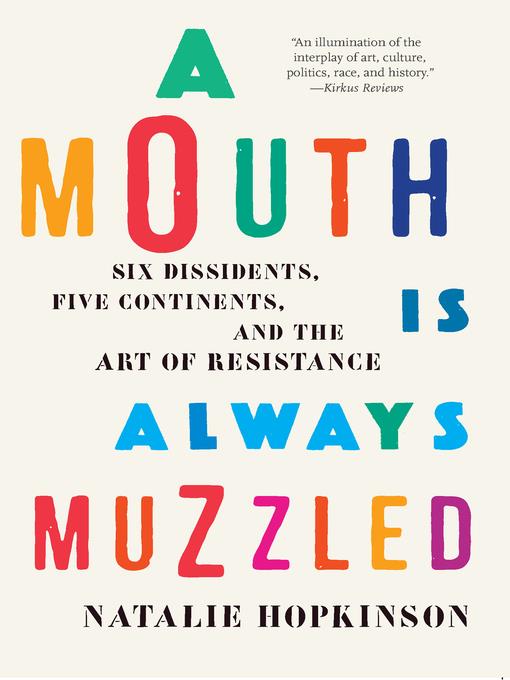
A Mouth Is Always Muzzled
Six Dissidents, Five Continents, and the Art of Resistance
کتاب های مرتبط
- اطلاعات
- نقد و بررسی
- دیدگاه کاربران
نقد و بررسی

November 6, 2017
Hopkinson (Go-Go Live) allows Guyana, the second-poorest country in the Western Hemisphere, to serve as a surrogate for other impoverished communities and to explore art’s role under politically oppressive regimes. The book opens with a colorful chapter on Mashramani, Guyana’s street festival held annually on the anniversary of the slave rebellion led by Cuffy. Information about the country’s history—from slavery and indentured servitude to former president Forbes Burnham’s 1970s celebration of Guyanese art—provides context on the country’s current political climate and the tensions between black and East Indian citizens, who battle for political control. While a well-written analysis of Kara Walker’s Sugar Sphinx statue provides an entryway for discussing Guyana’s sugar plantations and sugar’s role in the slave trade, it’s odd that Hopkinson devotes a chapter to a famous American artist, when a more thorough discussion of Guyana’s own artists could develop the book’s central question: can creative and intellectual work transform communities? Hopkinson’s powerful description of the murder of Courtney Crum-Ewing, the political activist who peacefully protested outside of attorney general Anil Nandall’s home, reveals no easy answers to that question. Hopkinson’s smart analysis of art and politics is worth reading, even if the book’s wandering focus can prove distracting.

November 15, 2017
An illumination of the interplay of art, culture, politics, race, and history in Guyana, a Caribbean country mostly ignored by the rest of the world but which serves here as a fascinating microcosm for the power of art to inspire change.This is a singular book, one that is not conventionally academic nor a conventional travel narrative nor a conventional work of arts criticism nor even a conventional piece of journalistic reportage, yet it draws from all of those disciplines as a deeply felt and passionately expressed manifesto. Cultural critic Hopkinson (Communication, Culture, and Media Studies/Howard Univ.; Go-Go Live: The Musical Life and Death of a Chocolate City, 2012) was born in Canada and has long lived in the United States, but she clearly feels a strong connection to Guyana, her parents' homeland. She sets the scene with Guyana's version of carnival, where there is a tension between unity and multiculturalism and where the government has co-opted so much of what was once indigenous culture in the country that "bills itself as the 'Land of Six Peoples.' " The setting is the eve of the 2015 election, and tensions are running even higher in a country where dissidents have not only risked repression, but death. As the author writes, "there are...ethnic grudges raging beneath the surface of every conversation here. Like an arranged marriage that began to rot ages ago, the various races in Guyana know exactly how to swing where it hurts." Hopkinson provides valuable context for colonialism, slavery, the importation of workers from India, the mythic El Dorado, and the death cult of Jim Jones, and she interweaves capsule histories of the brutal sugar industry and the empire built by the family that originally endowed the Booker Prize. The author also presents indelible portraits of activist writers and artists and of the martyr Walter Rodney.Not merely a book about Guyana, but an impressively rendered story about imperialism in general and cultural imperialism in particular.
COPYRIGHT(2017) Kirkus Reviews, ALL RIGHTS RESERVED.

February 1, 2018
If there is any certainty about postcolonial art, it is that its legacy remains complicated. In exploring her parents' native country, Guyana, Hopkinson (Deconstructing Tyrone, 2006) investigates this history by focusing on the traditional Mashramani celebration, which, unlike any other event, mixes all the ethnic groups living in the country in one raucous party marking the formation of the republic. She explores the cultural context for the coming together of six distinct and distant races in a small area of land in South America through the voices of six creative individuals within and inspired by the country's complex story: painter Bernadette Persuad, poet Ruel Johnson, conceptual-artist Kara Walker, poet Martin Carter, writer John Berger, and historian Walter Rodney. Hopkinson's thoroughly notated homage to Guyana is a revelation of past atrocities mixed with current political uncertainties. Even the title quote, from poet Carter, references both the struggle to voice dissidence and the effort to survive. Like all worthy human endeavors, Guyana's embrace of diversity and hope must endure. With this illuminating narrative, Hopkinson contributes greatly to that effort.(Reprinted with permission of Booklist, copyright 2018, American Library Association.)

























دیدگاه کاربران